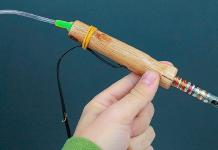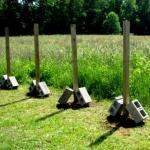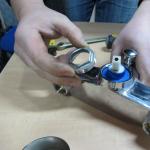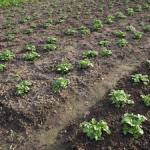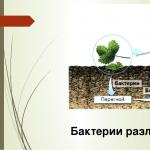Garter of indeterminate tomatoes:
Proper garter tomato - the key to a good harvest
Garter tomato in the greenhouse
It is easier to fix tomatoes in a vertical position in a greenhouse than in open ground. All that is required for tying plants is supports and garter material (narrow strips of fabric, nylon tights or stockings). For this task, plastic clips are excellent, which can be used for several seasons.
For tying, do not use wire, fishing line, thread, twine and other thin and hard materials.
Tying options
There are several of the most popular options for gartering tomato bushes. The choice of mounting option depends on the variety, the height of the adult bush, the yield of the type of greenhouse and other factors.
Tying to a separate support
This option is suitable for mini-greenhouses, mobile and small stationary greenhouses in which compact and medium bushes are planted. As supports you can use wooden stakes of approximately the same length, metal or plastic pipes and thick rods. They are installed next to each bush and must correspond to its height. A strip of fabric is wrapped around the stem, which is fixed on a support.
Wire frame mount
This method is used for small bushes with abundant fruiting. You will need a large-mesh metal grid, which is wrapped around the plant. It turns out a wide "pipe", the base of which is dug into the ground. If necessary, it can be moved to another place, and the stems and fruits are tied to it at any height. The only difficulty arises during the collection of fruits.
Line Mount
This is a very handy method that allows you to quickly and with minimal effort to establish most bushes, especially if you have a long greenhouse with densely planted plants around the edges. The structure can be mounted immediately after the construction of the greenhouse, and it consists of two metal pipes, which are installed at different ends of the shelter. Stretched between them rope, to which the bushes are tied at the same distance from each other. The disadvantage of the method: it will not be possible to fix tall and abundantly fruiting bushes in this way.
Garter tomato with trellis
A tomato garter in a polycarbonate greenhouse has its own characteristics. In particular, the trellis method of tying tall tomatoes is most often used there. A pair of strong supports is installed at different ends of the greenhouse, and ropes are pulled between them at different heights with an interval of 30 cm. High stems are attached to the ropes with plastic clips or threaded through a rope "net". This method of fastening allows you to conveniently arrange sprawling bushes with fruit-bearing stepchildren.
vertical trellis
This design is a variation of the previous one. It is ideal for gartering tomatoes and cucumbers, especially tall ones with side shoots removed. A rope is attached to the ceiling of the greenhouse, which is fixed at the base of the bush. As the plant grows, it "creeps" along it, and you only need to additionally tie up or fasten the bush with clips. With such a "rod" even the tallest and most fruitful bushes do not break.
Mesh mount
This is a combined version that combines trellis fastening and fixation with a grid. A metal or plastic mesh is stretched between the supports, which allows you to place powerful and compact bushes.
Garter tomato in the open field
Almost all of the above methods are suitable for open ground, the main thing is not to use natural fabric, as it rots and eventually becomes a breeding ground for pathogenic bacteria. Let's talk about the features of each method of gartering tomatoes.
1. Tomato garter stakes. In a greenhouse, plants are little affected by weather conditions. When grown outdoors, tomatoes have to contend with wind and rain, so the requirements for supports are tougher. For seedlings of undersized and medium-sized tomatoes, the stakes should be 25-30 cm higher than the bushes, and tall varieties need supports 2-2.5 m high. Each peg is deepened to a depth of 20-25 cm, while retreating from the trunk by 10- 15 cm, so as not to damage the root system. Do not pull the garter tight so that it does not pinch the stem.
2. "Cages for tomatoes"- for each bush or group, you can build a small separate structure in which the plants will be protected and securely fixed.
3. Caps. Unusual and convenient designs, suitable exclusively for open ground and any tall plants. The essence of the impromptu "wigwam" is the construction of a pyramid from improvised means. Most often, wire, vine or cross-linked stakes are used. The pyramid covers several young plants at once, and the distance between the structures should be about 1 m.
4 ."On hook". On both sides of the tomato ridge, sticks for tying the bushes should be installed. A rope is pulled between them. A fishing line with loops at different heights is attached to it (the distance between them should be 20-25 cm). S-shaped hooks made of thick wire are inserted into the loops, which pull the fishing line. Its other end is tied to a peg near each plant. Now it remains to bring an elastic rubber ring under a branch or a bunch of tomatoes (it can be cut out of a bicycle inner tube) and put it on a hook. As the bush grows, the hook is removed from the loop and threaded higher into the loop.
Unusual ways to garter tomatoes
All non-standard ways of tying tomatoes are to use the original support structures. For the implementation of many of them, willow twigs, hazel, blackberry stalks, cuttings of seedlings, woody and vegetable vines, twine or vines are used.
- hoop support. To create this support-cage, you need three perches and three hoops of different diameters. The diameter of the hoops increases from the bottom up, and the stem is attached to them with plastic clips.
- V-shaped lattice. In this case, two buried gratings are used, which deviate from each other in different directions. Plants are located between them and naturally support the structure throughout the season. The height of the grids should be selected depending on the expected height of the plant. It is not necessary to tie up the plants, they themselves freely "spread" along the trellis.
- Old TV antenna. Some items are already ready-made supports for tomatoes and other crops. For example, such as a branched mast or an unnecessary television antenna.

How to make tomato garter pegs
Various objects can act as supports for tomatoes. Planks, wooden boards and lignified branches, plastic and metal rods and rods, metal or plastic nets with large cells. The main thing is not to tighten the tomato garter loop too much so that the plant does not experience excessive stress.
What tomatoes can be grown without a garter
Can be grown without a garter undersized And early maturing varieties. Often they say that they do not require a garter determinant varieties. These tomatoes stop growing after tying 4-5 brushes. From the general group of determinant tomatoes, superdeterminant, which ripen very early and do not require pinching at all. In "simple" determinants, you need to remove extra stepchildren, otherwise you can get a plant overloaded with fruits, which will develop poorly.
But still, the best choice for those who dream of just planting a plant and enjoying the harvest is standard tomatoes. This is one of the varieties of determinant tomatoes, which are distinguished by a short and dense stem and small growth.
One of the biggest reasons to tie up tomatoes in a polycarbonate greenhouse is the development of fungal infections. Despite the fact that most varieties of tomatoes have stable immunity, mistakes made during cultivation and care can be fatal. For example, it is necessary to water tomatoes strictly under the root, which cannot be done when the bush is on the ground. Moisture, falling on the leaves, leads to the formation of phytophthora and the death of the crop.
Another reason why seedlings are tied up is fruit control. In a tied state, it will be easier to control the development of tomatoes, and due to the fact that the bush is securely fixed and it does not need to spend energy on maintaining the stems with fruits, the yield increases several times.
On a note!
Tying reduces the number of yellow and underdeveloped tomatoes, and also prevents the bushes from breaking.
What to use for tying a tomato
For tying a tomato, experienced gardeners recommend using fabric ribbons, preferably from cotton fabric (increases reusability), nylon pieces and twine. Do not tie the twine tightly, otherwise the bush may break.
 There are many ways to tie bushes. Most often resort to:
There are many ways to tie bushes. Most often resort to:
- trellis tying;
- use of individual support;
- free loop method;
- linear fastening;
- wire frame;
- growing on a grid.
For some unknown reason, gardeners were more fond of low-growing varieties of tomatoes, which is not clear why, because it is high bushes that are the most hardy and prolific. But undersized tomatoes, like higher varieties, need to be tied up or grown using a support.
Tying patterns

The most correct would be cultivation using trellis cultivation. The design of the trellis can be erected both on the open ground and in the greenhouse.
Attention!
This method is designed for a long time of use. And when changing the trellis, they will not only decorate your garden, but also help support the seedlings.
Trellis growing tomatoes

For such a design, you need:
- metal pipes or timber;
- wire, nylon cord;
- special mesh made of plastic with a large mesh;
- shovel, hammer and nails.
Be guided by the fact that the height of the tapestries should be at least 2 meters. This height is perfect for growing high varieties of tomatoes. Metal pipes or wooden blocks must be dug into the ground with a shovel 10-15 cm deep. For the manufacture of one trellis row, if the width of the beds is 2 meters, about 4 pieces are needed.
Then the bars can be pulled with ropes, one end of which will be attached to the bush. And if you need to get more sprawling bushes, then in addition to the rope, you need to stretch the net over the entire length of the trellis.
On a note!
As the tomato bushes grow, they will develop more evenly, ventilate, which will reduce the risk of developing fungal diseases, and harvesting can be controlled much more easily than if the bushes were lying on the ground.
Individual support

Recently, it has been used less and less, as it is suitable for small beds and serves as a temporary structure. In order to install an individual support, you can use:
- thin wooden bars;
- bamboo sticks (they can be purchased at any flower shop);
- plastic pipes;
- metal stakes.
The safest and most traumatic to use are plastic pipes. But other materials will cope with the “support” function just as well as them.
For installation, you need to cut the selected material to the height that the tomato variety can reach as much as possible. Next, the support must be dug into the ground to a depth of 5-10 cm and the support is ready.
Free loop method

In order to tie a tomato with a “free loop”, you need to clasp the bush with some kind of rope or cotton cloth at the root. Then spirally scroll the rope along the entire length of the seedling and lightly tie the end to the support.

Line Mount
Usually mounted immediately after the installation of the greenhouse.

On both sides of the beds, you need to drive in metal pipes on which a rope is attached, stretching along the row. Tie the seedlings to the rope at an equal distance. For bushes that are too tall with heavy fruits, this method is not the best.
wire frame
Ideal as protection against animals, as well as for growing mini-cultivars.

In order to build a frame, a coil of wire is needed. With the help of pliers you need to bend it in a circle. As a rule, it is necessary to make about 10 round blanks and fasten them together with transverse segments of wire. The disadvantage of this design is inconvenient harvesting, but the undoubted advantages are the protection of seedlings and the possibility of transferring the structure if necessary.
Mesh mount

In order to grow tomatoes using this method, you must:
- from 4 to 10 wooden, plastic or metal stakes;
- net coil not less than 10 m.
The most suitable stakes must be dug into the ground to a depth of at least 5 cm. The height must be at least 2 meters. After a row of stakes is built (the distance between them is no more than 50 cm), fasten them from above with a wooden beam, metal or plastic stake and pull the net from top to bottom. The structure is ready.
Common mistakes when tying a tomato

The most common tying mistakes include:
- the use of the wrong garter materials (many mistakenly believe that it is possible to attach a bush to a support even with a metal wire, but this is strictly prohibited);
- neglect of the processing of the garter material that was previously used (disinfection with alcohol will not allow bacteria and fungi to transfer from the previous crop to the new one, thereby preventing the development of many diseases and preserving the fruits);
- the choice of support and fastenings without taking into account the characteristics of the variety (for example, you should not choose a trellis fastening for undersized tomatoes);
- one-time tying (attachments to the support must be controlled during the entire growth of the tomato bush, otherwise, the seedling may break or reduce growth).

- Tie seedlings to any type of structure. Otherwise, not all bushes will be able to start weaving along the mount you have chosen.
- It is necessary to tie up only with the help of fabric strips, plastic rings, nylon tights. IT IS FORBIDDEN to tie seedlings to the fence using fishing line, wire, bundles, etc. They can simply cut the bush or break it.
- Pay attention to the variety of tomatoes: for high varieties, it is better to choose trellis, mesh or linear structures; for low - the height of the structure should not exceed 1 meter.
- Before installing the mount, carry out pinching.
- After tying to the support, water the bed abundantly.
In many places with a hot climate, tomato bushes are not tied up. The tomato stem is designed in such a way that lying on the ground, it receives additional proper nutrition, providing a huge harvest.
For our climatic conditions, including greenhouses, this method of cultivation is not suitable. Tomato culture must be tied up - for this there are special ways to tie up tomatoes in a greenhouse.
Required garter material
How to tie up tomatoes in a greenhouse is the main point in care.
To do this, you need such auxiliary material:
- cord with good strength;
- tape made of good material;
- a thread of twisted fibers that can withstand the load of the bushes.
Note!
When choosing a rope, be sure to pay attention to its thickness, it should not be very thin, as it will cut or injure the stems.
Gartering tomatoes in a greenhouse will prevent pests from attacking the bushes, and also help them withstand their own weight and mass of fruit.

Garter Methods
On an open plot of land or in greenhouses for tall tomato varieties with high yields, a garter is necessary so that the stems do not break. For beginner gardeners, the question arises, how to tie up tomatoes in a greenhouse? There are various ways to tie up, but the main thing is to follow the correct technique without damaging the tomato bushes.
Having reached a certain height, many stems begin to break, and under heavy watering, tomatoes lying on the ground can deteriorate. To avoid such troubles, you need to know how to properly tie tomatoes in a greenhouse.
Garter on a peg
The process consists of the following steps:
- a small rail is driven in near each bush at a distance of 10 cm, so as not to damage the roots of the plant;
- with the help of a rope, a stem of a tomato is tied;
- the rope should be near the top of the bush and should not pull the stem too much (due to a strong knot, the plant may die);
- a piece or rope is wrapped around the slat and stem several times, a knot is tied;
- as the bush grows, the rope must be moved, but it is better to tie the bush again, only higher.
Instead of rope, professional gardeners use patches from old synthetic fabric. Thanks to the properties of the synthetic fiber, the ropes will not rot when exposed to water. Before tying the tomatoes in the greenhouse, the material should be doused with boiling water to destroy possible bacteria.

The easy way
This method does not require repeated expenditure of time required for tying. Throughout its growth, the culture itself will wrap itself around the rope.
With your own hands, you will create a favorable environment for the growth of a tomato:
- bars with a thickness of more than 5 cm are placed at the ends of the beds;
- a wire is stretched between them along the entire length of the beds;
- we connect the tomatoes with the wire: we tie one edge of the flap to the bush, the other edge of the flap to the wire.
A variation of this method is even simpler:
- pegs are driven in along each edge of the row on both sides;
- a wire is stretched between the stakes;
- the wire prevents the plants from falling to the ground, giving them support.

Wire hook method
- A cable is stretched along the entire length of the row.
- Hooks are made from strong wire and cut from an old bicycle ring chamber.
- Above each bush, a fishing line or synthetic twine is tied to the cable, in which loops are made at a distance of 25 cm from each other.
- Hooks are threaded into the loops.
- A rubber ring is held under the stem of a plant or a bunch of tomatoes, it is bent in half and hooked on a hook.
- When the bush grows, a second garter is made: the next ring is threaded into an additional loop.

Combined method
The lower part of the plant is tied to a rail, the upper part is attached to a wire or trellis with twine. All ways of tying tomatoes in a greenhouse will help you to harvest a wonderful harvest.

Pasynkovanie tall tomatoes
Stepping is an important process necessary for the good growth of tomatoes. Any gardener should be able to do this.
Stepchildren - side shoots in tomatoes, which are formed from the axils of the leaves during the growth of the culture. Such shoots should be removed, as they then grow, and the bush is transformed into many stems with flowers, directing all its forces to the growth of greenery, and not the fruit.
With the help of pinching, tomatoes are formed, the plant produces prolific brushes up to 7 pieces.

Proper care of seedlings will speed up the process of fruit ripening and increase their size. Every ten days, it is necessary to cut off the grown shoots, preventing them from growing more than 5 cm. The stepchildren are removed simply: they are pulled down, and then they break themselves.
It is better to form seedlings in greenhouses in the morning. A simple instruction will help you get a good harvest.
A medium-sized tomato is more than 1 m high, with formations on the main stem up to 6 inflorescences. After the formation of such a number of inflorescences, the growth of the bush stops. Such a tomato mainly grows in several stems.
 3, 4 - parts of the plant to be pinched
3, 4 - parts of the plant to be pinched
For the formation of the second stem, one stepson is left, which develops from the axillary bud, located between the junction of the leaf and the stem. On this shoot further fruits are formed.
Having learned how to stepchild tomatoes in a greenhouse correctly, you will get more than 3 kg of fruit from each bush.
Rules for the formation of bushes
To achieve a high and high-quality harvest, the rules of pinching will help you:
- the plant is formed when the stems have become strong and moved intensively into growth;
- shoots have grown to 5 cm, which means they can be easily removed;
- remove shoots with your own hands;
- in the morning, the formation of a tomato is carried out;
- removal of stepchildren is carried out throughout the summer;
- before 11 am, a small shake of the plants is carried out, thus helping them to pollinate.
- The lower leaves are removed so that the fruits ripen quickly, evaporation decreases, and air exchange improves. You can pick up to 3 leaves at once, more will lead to a change in the fruit.
- After shaking, pour the flowers themselves from the spray bottle, moisten. Water intended for irrigation should reach a temperature of 20 degrees.

- After 2 hours, the room is ventilated, lowering the humidity. When performing, waterlogging of the soil is not allowed, and the tomatoes will be sweet and tasty, which you will not only eat yourself, but also be able to sell - because the price for them is always kept at a good level.
And ventilation holes. This procedure will prevent the roots and shoots of plants from burning. By airing the greenhouse at the right time, you can avoid various problems by growing this crop.

Summary
Tomatoes are a delicious, attractive fruit with many benefits. Knowing how to properly tie tomatoes in a greenhouse, you will get an excellent harvest. To do this, you should follow all the rules according to which the garter of tomatoes in the greenhouse is carried out and their formation.
You can see some more usefulness on the topic in the video in this article. Have a rich harvest and delicious fruits!
Tall varieties of tomatoes bear fruit abundantly, but the branches become unstable under the weight of large fruits. Therefore, the optimal conditions for growing are greenhouses and high-quality tying.
How to tie up tomatoes in a greenhouse correctly so as not to deal with alterations in the future? What methods of reliable fastenings for branches and stems exist? What is the best choice for a vegetable grower?
Basic information about culture
Tomato is an annual plant of the nightshade family. Suitable for growing in open or closed ground, on the windowsill, balcony.
Previously, the tomato was considered an exotic plant bred in Europe. In the 18th century it was brought to Russia. Today it is a common crop with a thin skin and juicy pulp, the seeds are located in the pericarp.
Why do you need to tie up tomatoes?
Tying is a simple but necessary procedure for tall tomatoes after pinching or the appearance of fruit ovaries. Tall varieties of tomatoes with large fruits are vulnerable to gusts of wind, and an additional load is placed on the stem. The correct garter of tomatoes in the greenhouse will contribute to:
How to tie tomatoes in a greenhouse
- protection of plant stems from breakage, breaking off;
- increase in yield, because under the weight of a large number of fruits, tied heavy branches will no longer break;
- preventing the development of rot on the leaves, since with vertically standing bushes it will be possible to irrigate directly under the root, moisture will fall on the leaves and there will be no more fruits;
- avoid contact of leaves with wet soil;
- full supply of air and light to seedlings in order to accelerate the ripening of tomatoes;
- simplification of care for seedlings (stepping, fertilizing, weeding) and harvesting from bushes in a standing position.
The note! The greenhouse does not have a large usable area, so it is worth using all its parameters for their intended purpose: height, width, length. For these purposes, supports are used so that a large number of seedlings can be grown on one square meter of usable area.
Garter tomatoes in the greenhouse - methods and devices
There are several ways to properly tie tomatoes in a greenhouse. It is recommended for vegetable growers to choose the optimal attachment scheme in advance, even before planting seedlings in the greenhouse. This will help to avoid alterations in the future, to prevent damage to the stems and root system.
It is important to tie tall tomatoes and do it correctly, since even the strongest and most developed root system is unlikely to withstand overgrown stems that can quickly break under the weight of the fruit as it ripens. Before the garter in the first place is:
- stepchild seedlings;
- establish the optimal type of support, taking into account a particular variety of tomatoes;
- stock up on tying material for work;
- tie up each bush, water abundantly.
The best ways of fastening are individual support, wire frame, rope (mesh) fastening, trellis.
Individual support
This is the best option for small greenhouses and film greenhouses with the growth of medium or compact tomato bushes. As a support, thick rods, pipes (metal, plastic), wooden pegs are used. For fastening you need:
- install a support next to each seedling so that the height corresponds to the level of the grown bush;
- wrap a strip of fabric around the stem;
- tie to a support.
Reference! It is better not to use this option for tall tomato specimens due to the possible fall to the ground along with the support.
horizontal support
A strong rope or long reinforcement is pulled right under the ceiling of the greenhouse. As a support, you can use perches, slats. Seedling stems are tied with ropes at a height of 10-12 cm with entanglement of the stems in several places at once, but without excessive tension on the rope to avoid pulling out the bushes even with a slight wind when tied to a horizontal support. When the stems gain strength and get stronger, they themselves will begin to pull the rope with optimal strength.
It is better to tie the rope to small pegs, and not to stems. The method will help strengthen the bushes as much as the height of the horizontal support allows. Even if the stems are very elongated, they will be located directly on a horizontal support in the future.
wire frame
For the construction in the greenhouse, a large-mesh metal mesh is applicable for wrapping around each seedling. This is a wide tube, suitable for bandaging more compact bushes, but with the growth of a large number of fruits. The advantage of the wire construction is the possibility of attaching stems and heavy branches with fruits, dismantling with transfer to another place if necessary. Although harvesting with this method is inconvenient. The option can become costly and time consuming if there are a large number of bushes. Garter steps:
Metal grid
- wrap a metal coarse mesh around each seedling;
- dig lightly into the ground;
- tie the plants with ropes to the mesh loops.
Line Mount
The optimal, economical option, although it may not be suitable for tall bushes weighted with clusters. It is used immediately after the arrangement of the greenhouse when growing a large number of tomato bushes. Step-by-step instruction for linear fastening:
- drive metal tubes into the soil on both sides of the beds immediately after arranging the greenhouse for support;
- pull a rope along each row;
- fix at an equal distance from each other;
- tie seedlings to the cord;
- stretch a wire or rope along the tomato row;
- tie the plants to twine.
rope trellis
An acceptable option for use if beginners do not know how to tie up tomatoes in polycarbonate greenhouses. If you plan to grow tomatoes in a greenhouse throughout the year, then it is convenient to install a vertical trellis - an option for tall varieties after cutting their side shoots. The method of tying tall tomatoes in a greenhouse, sprawling bushes with fruit-bearing stepsons will help to keep heavy fruits. The support under the weight will not fall and will not break. Step-by-step instruction:
- install strong metal poles on the sides of the greenhouse;
- dig into the ground at a distance of 35 cm from each other;
- pull the rope so that you get a strong mesh;
- tie tomato bushes or fasten to plastic clips.
Advice! It is important to pull the support rope soft, strong and wide so as not to injure the branches. Alternatively, you can stretch a grid with large cells between the posts and attach the stems, tomato branches to it later.
mesh mount
An alternative to a rope trellis with a plastic or metal mesh stretched between the posts. As the seedlings grow, if necessary, it will be possible to untie the trellis, remove it from the hooks, move it and fix it in a new place.
The mesh is attached under the ceiling of the greenhouse so that the lower edge hangs at a height of up to 1 meter above the ground. The top edge should remain under the ceiling or else be laid horizontally for the subsequent location of the lowest stems on it.
You can tie tomatoes to the net on special devices, ribbons and ropes, the size of which should be selected taking into account the length of the stems. The smaller the bushes, the longer the rope should be, it will serve as an additional fastener as the stems are pulled to the net.
Reference! To select the best option for gartering tomatoes, experts advise trying several at once. Of course, you can immediately buy a capital fixture in the store. This is more expensive, but you can attach any tall vegetables (eggplants, cucumbers) if necessary.
Many vegetable growers prefer to tie tall tomatoes directly to the roof of the greenhouse. It is convenient and does not require additional investments. Although you have to tie up each stem separately, or save only 1 stem from a tomato. Also, the option is not appropriate when tying tomatoes in a polycarbonate greenhouse.
In order to avoid damage to the roots and stems, in order to simplify the care of seedlings, when choosing the optimal mounting option, it is worth considering:
- variety of tomatoes;
- the height of the bushes;
- productivity;
- greenhouse type.
It is necessary to develop a plan and a tying scheme in advance.
Rods, tubes, pegs are the easiest option for tying seedlings that have reached a height of 25-30 cm. Although it is unreasonable to drive in high stakes in a greenhouse, since a strong wind can damage the roof, especially if it is made of thin, fragile polycarbonate.
In order to avoid damage to the roots of tomatoes, it is wise to drive pegs into the ground first, install a greenhouse and plant seedlings last. Stages of tying the stems:
- driving in pegs, metal rods near each seedling;
- tying with cotton ribbons 4-5 cm wide with loose knots.
It is desirable to drive in a peg or wooden block from the north side of each bush. You need to tie the stems to the rails almost at the very top, twisting 2-3 turns around the peg and tying a tight knot.
Tomato garter pegs
Bush tying devices
According to many farmers, it is convenient to use duct tape and a garden pruner-like cutter that cannot damage the stems of plants. It is enough to fix the branches at the right level with their help. The tape is easily removed, and additional clamps will give convenience when tying tomatoes to the trellis.
Attention! It is undesirable to use plastic, synthetics for a garter. It is better if it is a material of organic origin.
You can buy reusable plastic devices in stores. It is also convenient to install a trellis support for tall tomatoes. The main thing is that sanitization is carried out before use.
Often, gardeners use flaps, paper fabrics, twine, nylon tights that will not overlap the plantings, and they can be used several times during the season. The optimal width of the strips is 2-3 cm.
Not suitable material for tying, capable of pulling and pinching the stem, damaging the plants:
- fishing line;
- thin twine;
- wire;
- thin kapron thread.
Hard or thin material will gradually rub, cut the trunks of seedlings. As a result, this can lead to damage, breaking the bushes.
Important! Mounts for tomatoes must be strong, reliable. Poor work will lead to a fall, breakage of the stems and trunks of tomatoes under the weight of the fruit.
Convenient plastic clips that fasten with one hand and withstand any load. They can be used repeatedly, and it is not difficult to choose sizes, taking into account the volume of branches, stems, and even fruits. You can tie up tomatoes in a polycarbonate greenhouse using a fiber thread, a thin bundle, a cord, a ribbon.
Many gardeners, in the old fashioned way, tie up tomatoes with shreds of cloth, driving in pegs near the stems. But in order to avoid the defeat of young, fragile seedlings with diseases, the material must be of high quality: it must not deteriorate, break off from the wind, watering. It is wise to use synthetics for tying tomatoes, but the fabric should not stretch too much, otherwise it can cut the stems of tomatoes and lead to a fungal infection.
If fabric strips are used, it is recommended to pre-soak them in a disinfectant solution or boil them. It is necessary to tie up the seedlings carefully, without bending the main stem, without pressing it strongly with matter. There should be no contact between the trunk, the rag and the stakes.
garter of tomatoes
Here are some tips for beginners and experienced gardeners:
- It is not recommended to tie the stem to the support with a figure eight in order to avoid possible confusion.
- It is desirable to make a garter not only stems, but also weighty brushes of fruits for their own safety.
- Individual stakes as a way of garter are more suitable for medium-sized varieties of tomatoes, and trellis - for tall ones.
- Do not allow the fruits to come into contact with the soil in order to avoid damage by late blight.
- Be sure to tie up the tomatoes when their stems begin to bend slightly in the ground so that they do not deform.
- It is best to build a complex support structure. The more difficult it is, the easier the process of growing tomatoes will be.
- When choosing a material, it is worth considering the time of tying, the degree of formation of the bush. Of course, the wire is not suitable for young seedlings, as it begins to pull the stems, it can lead to damage to the lashes, the formation of an unmarketable appearance in tomatoes.
- Moisture should flow freely to the upper parts of the bushes, which should be considered when choosing material for tying tomatoes.
A competent choice of garter method will increase the yield of tomatoes. Tying tall, high-yielding tomato bushes is an important stage in growing. The main thing is to take into account the conditions of the area, the design of the greenhouse, the stage of growth of the vegetable, in order to make it easier for yourself in the future, and also be able to change the mount when the bushes get stronger and grow strongly.
Tall varieties of tomatoes are often grown in greenhouses, they bring a large harvest and grow well in greenhouses. such tomatoes require a mandatory garter - under the weight of the fruit, not only the branches, but also the stem itself can break off. When growing this crop, beginner gardeners often make mistakes by tying the stems incorrectly and with the wrong material, which greatly affects the quality and quantity of the crop. Consider the most common options for attaching stems.
The stems of indeterminate, tall tomato varieties are subjected to constant increased stress as soon as the first fruits appear on them. For support, different methods of garter are used, which:
- protects the stems from strong bending and breaking off;
- simplifies the care of culture;
- provides good air exchange, due to which the risk of damage to the culture by fungal diseases is reduced significantly;
- does not allow the fruits to come into contact with the soil - the possibility of rot is excluded;
- the rate of ripening increases, as the fruits receive more sunlight during the day;
- reduces harvest time.

Based on the above, we can safely say that the garter not only preserves the crop, but also contributes to the friendly ripening of the fruit.
How to tie up tomatoes in a greenhouse?
Bushes are fixed with garter material and supports. For a garter, you can use various materials at hand, for example:
- soft fabric, cut into strips;
- kapron tights;
- knee socks;
- soft twine.
After the crop is harvested, the garter material must be washed and disinfected. After that, the strips are twisted and removed until the next year.

Never use for garter:
- thin, hard twine;
- fishing line;
- threads;
- wire.
These materials can severely injure the bush and break branches with fruits.
Now there are a lot of new products on the market that make it easier to care for any plants. You can buy special devices for fixing bushes:
- Retainer with tape- a hybrid of a stapler and a garden pruner. This device helps to quickly and accurately fix the layers with the fruits. The tape is very soft and does not injure the bush. If a trellis garter system is equipped in the greenhouse, this tool will be indispensable.
- Plastic clips for garter tomatoes - an inexpensive, easy-to-use garter option. It is enough to wrap the clip around the stem of the plant and snap it into place. These elements are made of high-quality plastic - environmentally friendly and durable. Can be used to fix stems and branches with tomatoes.

If there is no desire to buy industrial fixtures for fixing, then use improvised material.
Ways to tie tomatoes in a greenhouse
Before planting tomatoes in open ground, you need to decide on the method of tying the plants, since it depends on how far the bushes will be from each other. There are a large number of supports that can be used to fix the culture:
- Individual garter- a frequently used method for which it is enough to prepare small pegs, the length of which is equal to the height of the bush.
- wire frame- a mesh with a large mesh is twisted into a wide pipe and installed on each bush.
- Line Mount- pipes are installed in the end parts of the greenhouse, between which a rope is stretched.

- Tapestry fixation- can be vertical or solid. In a polycarbonate greenhouse, for example, during its installation, capital supports are installed, between which a rope net is stretched.
- Mesh mount- in the aisles, a polypropylene mesh with large cells is pulled.
The type of garter is chosen based on the design features of the greenhouse, the variety of tomato. All capital and permanent supports are installed in greenhouses, which are used year-round.
Such types of garters as tapestry or mesh are the most reliable in this situation. They are durable, and withstand heavy loads in the most high-yielding years.
As for linear fixation methods, they are used in small structures made of glass, polycarbonate or film. Suitable for medium-sized varieties and undersized bushes at the time of crop formation. It is better not to tie tall bushes on such supports, they are not strong and can break off under the weight of the bush.
Gardeners who grow ultra-early varieties of tomatoes use the same supports, tomatoes give a harvest very early, and after these crops other vegetables are planted in the greenhouse.

How to properly tie up tomatoes in a greenhouse?
Tomatoes, especially tall ones, require a garter. To fix correctly, you need to follow the following tips:
- before starting the process, make pinching;
- the type of support is selected based on the variety of tomato and the height of the bush;
- prepare the necessary components;
- fix the bushes;
- water the tomatoes.
For a garter, it is better to use natural materials:
- wooden pegs or metal rods;
- linen twine;
- strips of cotton fabric 4-5 cm wide.

The easiest and most common way to tie tomatoes is with wooden pegs. It is done like this:
- prepare the right amount of small bars, about 3x3 cm, a little longer than the height of the bush;
- on the north side, drive a peg into the ground so that it is stable and can withstand the load of a bush with fruits;
- take a small piece of fabric and tie the stem closer to the crown;
- as the tomato grows, an additional garter is made.
- drive in one bar 5x5 cm at the ends of the beds;
- stretch a thick wire or rope between the supports at the desired height;
- tie a strip of fabric at the very base to each bush;
- fasten the opposite end to the rope from above.

The advantage of this method is the fact that as the plant grows, it will not be necessary to re-tie it, just wrap the top around the flap.
It is worth disassembling the technically more complex trellis method of garter, it is performed as follows:
- take a few metal rods - the number depends on the length of the beds, and drive them between the bushes;
- pull a stiff string along the entire height of the stakes in 30 cm increments;
- as the plant grows, it is tucked between the twine as if weaving;
- heavy branches with fruits are tied up additionally, or hung on plastic hooks.
With this garter system, up to three stems can be formed on a bush.
It is not difficult to build supports for fixing tomato bushes, the main thing is to choose the appropriate option for a particular structure and tomato variety. Let us dwell on the basic requirements applied to the garter:
- you can’t tie the stems with wire or in the shape of a figure eight - the bush will be pulled over and die;
- fix not only the bush itself, but also the brushes with fruits;
- for medium-sized tomatoes, individual props are installed;
- tall tomatoes are best fixed on trellises;
- the garter is carried out at the moment when the plant begins to lean to the side;
- do not neglect the complex designs for the garter, as the process of growing tomatoes will be much easier.

To obtain a high-quality crop and plant health, the distance between the support and the stem should not be less than 2 cm.
You can also watch this video, where they will tell you how to quickly tie a tomato in a simple and reliable way.

